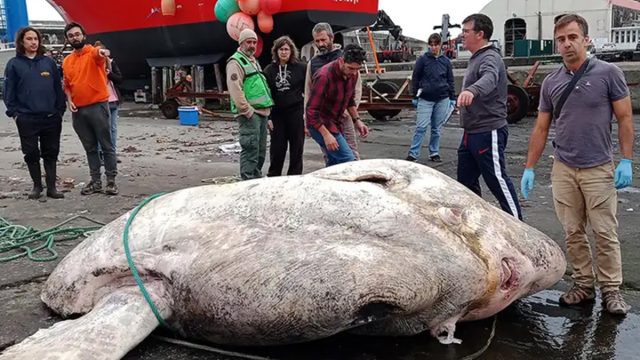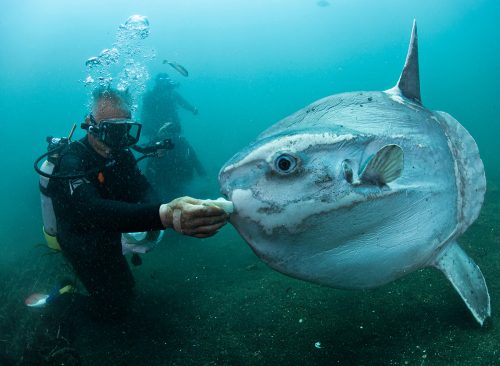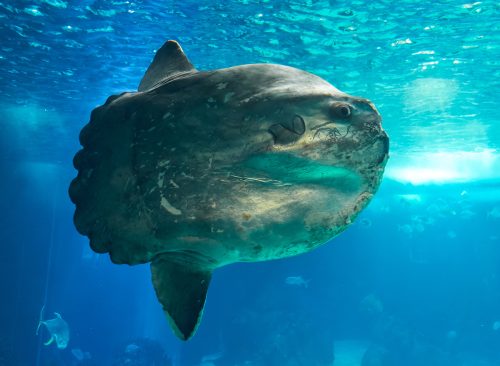Video Shows the Heaviest Bony Fish Ever Discovered.”The Size of a Hippopotamus.”
"A king of the open ocean."

Catching a huge fish usually makes for Instagram bragging rights and the occasional photo on a local watering hole’s wall of fame. But a recent catch in the Azores went one league beyond—this monster haul interested scientists.
The Journal of Fish Biology reports that a giant sunfish was caught that weighed more than 6,000 pounds—that’s almost three tons, about the size of an SUV or a hippopotamus. It’s the heaviest bony fish ever discovered, more than 800 pounds heavier than the previous record-holder.
“It’s pretty rare to find big fish these days due to overfishing and habitat degradation,” Kory Evans, a fish ecologist at Rice University, told the New York Times. Read on to find out what else about the fish made scientists’ jaws drop.

The giant fish was caught last year, but its existence was only reported by the scientific journal this month. Locals residents of an island off the Azores, near Portugal, discovered the monster fish—officially a sunfish, scientific classification Mola alexandrini—while at sea.
The fisherman towed the fish to shore with a boat and hauled it onto land with a forklift. Once it was on shore, researchers from the Atlantic Naturalist Association and Azores University weighed and measured it, and took tissue samples for DNA testing. It measured 12-by-11 feet and weighed in at 6,049 pounds. Researchers determined its skin was eight inches thick, and it was probably about 20 years old. Keep reading to learn more and see the video.

The catch didn’t involve a Moby Dick-style struggle of man against monstrosity. Fishermen found the sunfish floating dead off Faial Island. The Telegraph reports it had a bruise on its head and was marked with a smear of red paint, suggesting it had died after being hit by a boat.
After it was analyzed, the fish was buried on Faial Island. Sunfish were first recognized as their own species in 2018 and are known to weigh twice as much as the second heaviest fish species, the ocean sunfish, the Atlantic Naturalist Association says.

José Nuno Gomes-Pereira, a marine biologist at the Atlantic Naturalist Association in Portugal, called the fish “majestic” and a one-time “king of the open ocean.” He noted that the creature’s “sad” appearance in death didn’t indicate how impressive it must have been when alive. The catch illustrates that “the oceans are still healthy enough to sustain the heaviest species existing,” Gomes-Pereira added.
He said the fish was no genetic freak—there are probably similarly sized megafish out there. “This species can get to this size, we just finally managed to weigh and measure one,” he said. “There are more of these monsters out there.” “It’s a warning for us in terms of the need for further conservation measures,” he told the New York Times.

The Azores sunfish is 882 pounds heavier than the previous record-setting bony fish, a giant sunfish found near Japan in 1996. According to Guinness World Records, the world’s heaviest fish species is the whale shark. The heaviest was found in Pakistan in 1949 and weighed in at 21.5 metric tons.

Bony fish is an umbrella term for 29,000 species of aquatic animals that have skeletons made at least partly from bone, rather than cartilage. They range in size from tiny to record-setting. More than 90 percent of all fish are bony fish. (The other type of fish is cartilaginous, meaning their skeletons have cartilage. Sharks, skates, and rays are included in this group.) Sunfish have large, round bodies and a unique rounded rudder (called a clavus) which is formed when their back fin naturally folds into itself. Sunfish are clumsy swimmers, and they can’t fully close their mouths, which are tiny compared to their massive bodies.














